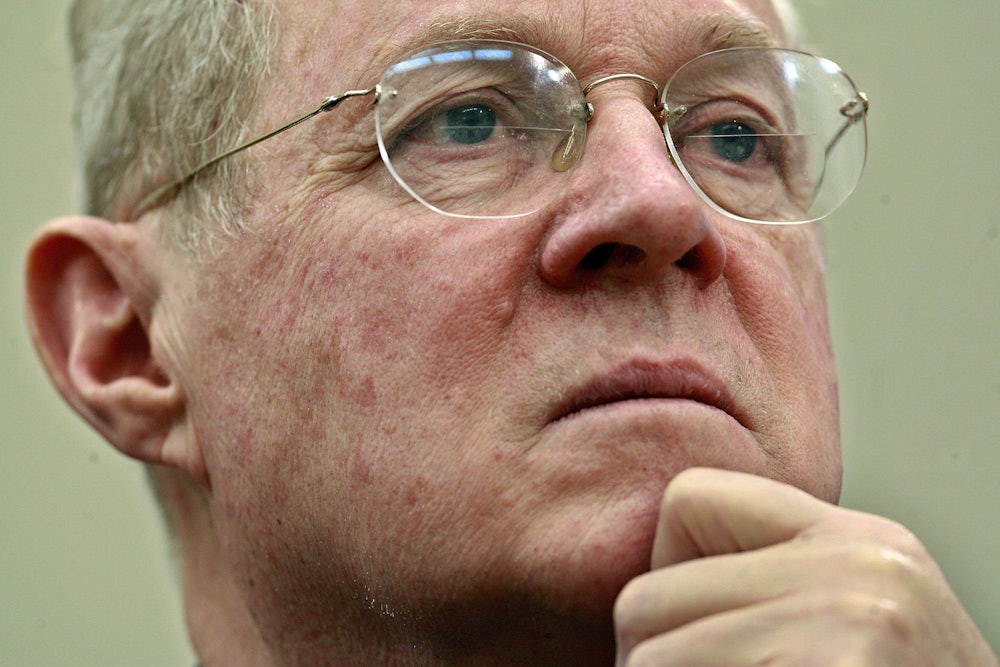The University of Texas faced a tough uphill climb in defending its affirmative action program before the Supreme Court. The death of Antonin Scalia, a staunch foe of affirmative action, didn’t necessarily figure to make a difference in Fisher v. University of Texas, since Justice Elena Kagan recused herself (she had been involved in an earlier iteration of the case as solicitor general for the Obama administration). This meant that four of the remaining seven justices had never voted to sustain an affirmative action program. Never, that is, until today. In Fisher, Justice Anthony Kennedy finally found an affirmative action program he believed to be constitutional.
UT’s admissions system attempted to create a diverse campus using a combination of formally race-neutral and race-conscious practices. Seventy-five percent of UT Austin’s prospective student body are admitted through the Top 10 Percent program, which guarantees admission to students in the top 10 percent of their graduating class. The remaining 25 percent of the class is determined through a combination of factors. In this process, race can be considered as a “factor of a factor”—that is, as one element of “special circumstances” used to place a student’s academic credentials in context. These factors include an applicant’s economic status, parentage, and household language.
Kennedy, joined by Justices Ruth Bader Ginsburg, Stephen Breyer, and Sonia Sotomayor, found that the program passed constitutional muster. Admittedly, Kennedy’s opinion was narrow and cautious. He emphasized that the Texas program “is sui generis,” and warned that “[i]t is the University’s ongoing obligation to engage in constant deliberation and continued reflection regarding its admissions policies.” But Kennedy’s rejection of the specious argument that all racial classifications—whether inclusionary or exclusionary—are a violation of the Equal Protection Clause is nonetheless very important.
The strongest parts of Kennedy’s opinion dealt with Fisher’s contention that UT’s attempts to increase diversity on campus can and should be done exclusively through formally race-neutral measures. First of all, UT presented “significant evidence, both statistical and anecdotal,” that race-neutral measures are inadequate to create a sufficiently diverse campus. Given the compelling interest the state has in such diversity, it must be allowed to experiment, he said.
Even more important from a constitutional (if not a policy) perspective, Kennedy correctly argued that calling the Top 10 Percent system “race-neutral” is disingenuous. Kennedy’s opinion quoted Justice Ginsburg’s observation that such plans are “adopted with racially segregated neighborhoods and schools front and center stage,” and that “[i]t is race consciousness, not blindness to race, that drives such plans.” The Top 10 Percent plan was designed to increase racial diversity. Indeed, unless someone has a secret plan to immediately end endemic de facto school and neighborhood segregation, it is bound to have this effect in practice, since it will guarantee college placement for students in predominantly minority schools.
Kennedy’s increasing impatience with the blind formalism of his Republican-appointed colleagues helps to explain why he finally decided to uphold an affirmative action program. In the 2007 case Parents Involved in Community Schools v. Seattle School District No. 1, Chief Justice John Roberts held that race could not be used even as a tiebreaker to choose between equally qualified applicants, based on the fatuous tautology that “[t]he way to stop discrimination on the basis of race is to stop discriminating on the basis of race.” Given a background of extensive historical de jure discrimination and persistent de facto segregation, however, the idea that simply ignoring race is sufficient to address racism is an obvious fiction.
Justice Kennedy regrettably joined Roberts’s judgment, but wrote a lengthy, somewhat tortured concurrence in which he refused to endorse the implied conclusion that affirmative action programs are never constitutionally permissible. I will admit to being skeptical that the distinctions drawn by Kennedy in that case would ever make a difference, but today they did.
There is no small irony in the fact that Justice Samuel Alito, who wrote a long dissent to Kennedy’s opinion, is an alumnus of the Concerned Alumni of Princeton, a group that opposed the gender and racial integration of the university. He is hardly the first conservative to opportunistically discover the value of “colorblindness” once its effects were to make campuses more, rather than less, white.
Alito’s opinion attempts a number of would-be “gotchas” that aren’t very convincing. At one point, he complains that “UT also offers courses in subjects that are likely to have special appeal to members of the minority groups given preferential treatment under its challenged plan.” I confess it is not obvious to me how offering, for example, a Black Studies program and giving students substantial freedom to choose courses demonstrates that the University of Texas is not really committed to racial diversity. Alito also chides UT for using SAT scores, which have “often been accused of reflecting racial and cultural bias.” But, of course, the correlation between SAT scores and racial socioecomomic status is exactly the kind of factor UT’s holistic admissions evaluations—which Alito considers unconstitutional—are designed to take into account. UT is constitutionally permitted to ignore SAT scores—but should also be constitutionally permitted to consider them while placing them in the proper context.
Whatever you think of the policy arguments surrounding affirmative action, the question is whether the programs are constitutionally permitted. And the argument that affirmative action programs are the constitutional equivalent of segregation has never made much sense. The Fourteenth Amendment does not require “colorblindness”; it forbids invidious discrimination. Kennedy, for once, has proven he understands this.
